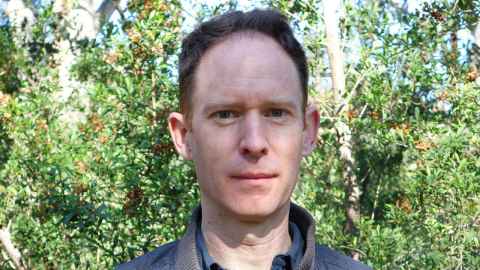Awakening associations with Gretchen Albrecht
27 May 2024
Luke Smythe drew on connections to Gretchen Albrecht that stretched back to his childhood for his extensive book on the artist.

You could argue Dr Luke Smythe started researching his first book when he was nine years old.
It was the mid-1980s and his parents took him and his cousin to a studio on Auckland’s Quay St to look at some paintings by their friend Gretchen Albrecht.
“My parents asked us for our opinions, and I pointed to one and I remember just going ‘I like those colours’. And my parents got it.
The work – two huge, glowing quarter-circle panels, one purple, one green, butting together to form a distinctively Albrechtian hemisphere – became part of Smythe’s childhood. It was called Colloquy (2) (Reflection).
“I can still see the painting kind of floating on the wall in the dining room.”
Three-and-a-bit decades later, the artwork also ended up in Gretchen Albrecht: Between Gesture and Geometry, an extensively illustrated monograph in which Luke traces his friend’s life and work: inspiration in a high-school art class; studies at Elam art school; the critical and commercial success that continues today, in Albrecht’s 81st year.
Now the 2019 book is back in a revised edition that expands on the 1970s section (“Gretchen happened to find a number of paintings in storage”) and brings it up to the minute (“She has made a significant amount of work in the past four years”).
Luke is speaking from Berlin, where he’s researching a book on painter Sigmar Polke, but he’s about to return to Melbourne, where he lectures in art history at Monash University. He has a BA from the University of Auckland, an MA from Columbia and a PhD from Yale: his thesis became the basis of a 2022 book on Gerhard Richter.
The Albrecht book, though, will always be a career pinnacle. Writing it took nine months, but it had been “percolating” for years. In the 2000s, Luke spent years cataloguing her work, “so I probably laid eyes on as many of her works as it’s possible to lay eyes on”.
Albrecht is important as a female artist who achieved great success in a man’s world. What’s striking, though, is the early support she received from male curators and artists, including Hamish Keith, Colin McCahon and Gordon Walters.
I probably laid eyes on as many of her works as it’s possible to lay eyes on.
“That needs to be part of any history of women’s art, right? In a world controlled by men, some women benefit from the assistance of men, who aren’t always out to keep women down. And she succeeded by dint of hard work.”
Albrecht’s art is “very beautiful, and people respond to that”. But Luke also wants to be clear about its importance in the broader history of abstract art.
“By the mid-20th century, there was this movement called Formalism, which maintained a painting was only shapes and colours on the flat surface, and don’t you dare say that they look like something because that would be a Philistine response.”
By the 1970s, says Luke, such ‘pure’ abstraction was catching on in New Zealand.
Yet as Albrecht embraced abstraction through the 1970s, her work still held connections to ideas, words and objects in the world – what you might call ‘impure’ abstraction.
Yes, there were landscapes in the horizontal layers of her 1970s ‘stained acrylic’ works; yes, there was a conversation taking place on the Smythe dining-room wall between the two halves of Colloquy (2).
This was bold. “Gretchen may have been the first person to part company with what had become the orthodoxy of Formalism in New Zealand. She wasn’t being antagonistic; she was just going to do what she felt she wanted to do,” says Luke.
“People couldn’t go on forever pretending that abstract paintings don’t awaken associations, but Gretchen really embraced them. That’s what makes her important.
This article first appeared in the Autumn 2024 edition of Ingenio.